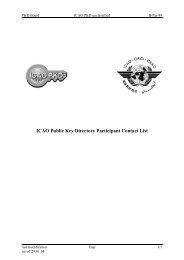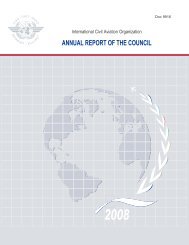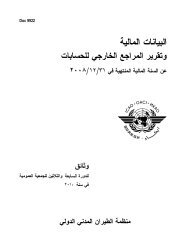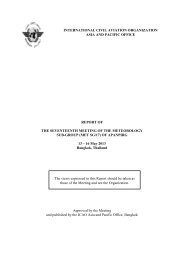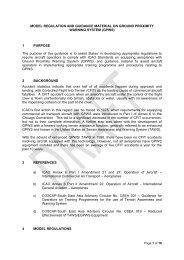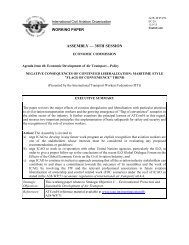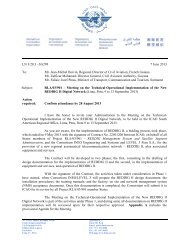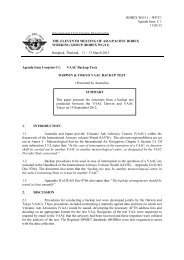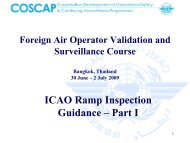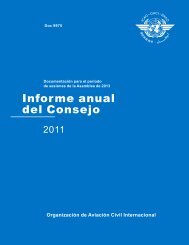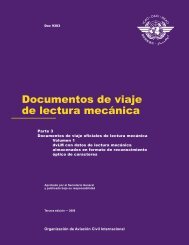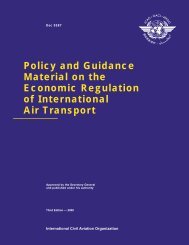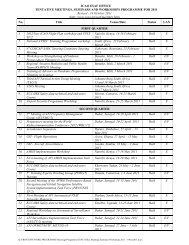afi met bulletins exchange (ambex) handbook - ICAO
afi met bulletins exchange (ambex) handbook - ICAO
afi met bulletins exchange (ambex) handbook - ICAO
You also want an ePaper? Increase the reach of your titles
YUMPU automatically turns print PDFs into web optimized ePapers that Google loves.
AMBEX HANDBOOK 7th Ed. 30/58<br />
detailed information of the changes and the proposed time schedule. The Regional Office should inform<br />
all other <strong>ICAO</strong> Regional Offices of the changes to be introduced and the effective date of implementation.<br />
12.1.3 All requests by users for changes to AMBEX <strong>bulletins</strong> should be addressed to the <strong>ICAO</strong><br />
Regional Office concerned. The Regional Office should carry out the necessary coordination with the<br />
Sates and AMBEX centres concerned. The duration of the coordination process should be minimized so<br />
that the period between the user request and the implementation of the change (if agreed) should normally<br />
be less than 3 months.<br />
12.2 Quality Management of OPMET Exchange under the AMBEX Scheme<br />
12.2.1 Objectives and Scope<br />
12.2.1.1 Objectives: Develop a management system that provides general guidance on procedures<br />
applied to OPMET <strong>exchange</strong>, which includes quality control aspects and introduces a non-real-time<br />
monitoring for OPMET <strong>exchange</strong>.<br />
12.2.1.2 Scope: Management of OPMET data <strong>exchange</strong> will be organized in the following<br />
sections:<br />
Quality Control Data quality control applies to OPMET validation and correction during data<br />
processing and during preparation of messages<br />
OPMET Monitor and evaluate the performance indicators for the scheduled OPMET data<br />
monitoring<br />
12.2.2 Quality Control – General Requirements<br />
12.2.2.1 Quality control (QC) consists of examination of OPMET data at NOCs, AMBEX Centres<br />
and RODBs to check the messages for formatting and coding errors, as well as, for time and space<br />
consistency.<br />
12.2.2.2 OPMET data should be checked in real time or as close to it as possible, at the first point,<br />
i.e., the originator, which may be: <strong>met</strong>eorological station, aerodrome <strong>met</strong>eorological office or<br />
<strong>met</strong>eorological watch office. Errors may occur during coding or transcription of <strong>met</strong>eorological messages<br />
by the observer or forecaster. The originating office should apply quality control procedures during data<br />
processing and preparation of messages, in order to eliminate the main sources of errors.<br />
12.2.2.3 The national OPMET centre (NOC) should apply QC procedures on the incoming<br />
messages from national sources and on the compiled national <strong>bulletins</strong>.<br />
12.2.2.4 It is also advisable to apply QC checks at the AMBEX Centre, where the AMBEX<br />
<strong>bulletins</strong> are received or compiled. If automation is available it should be used, or partly assisted by<br />
computing facilities. The principle is that every message should be checked, preferably at the various<br />
points along the data chain.<br />
12.2.2.5 The checks that have already been performed by originating offices and AMBEX Centres<br />
are usually repeated at the OPMET data banks. Erroneous messages found by the RODB should be either<br />
rejected or corrected by reference back to the source or by the data bank itself. Data corrected by the data<br />
banks should be flagged in the database for record purpose.<br />
12.2.2.6 As a result of the quality control process described above, OPMET data of established<br />
quality will be used in the <strong>exchange</strong> and stored in the data banks. The RODBs should compile



